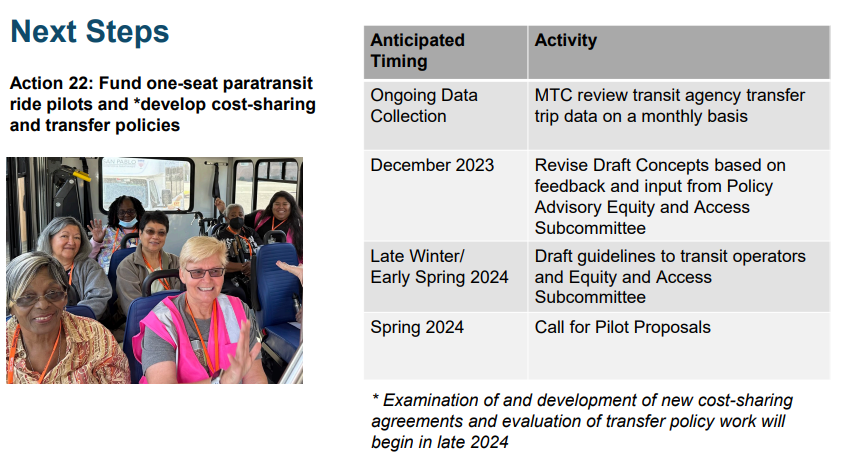East Bay Paratransit looking to join One-Seat Ride Pilot Program
East Bay Paratransit is set to join MTC’s One-Seat Ride Pilot Program, creating a more seamless experience for riders taking trips that cross agency service boundaries and with potential cost savings for paratransit service providers.
Mallory Nestor, Accessible Services Manager at AC Transit, confirmed that East Bay Paratransit plans on participating in MTC’s pilot program during the November 29th BART-AC Transit Interagency Liaison Committee meeting. AC Transit plans to submit an application in April, around the time when MTC will open its call for pilot proposals.
A map of the East Bay Paratransit service area.
Under the current landscape, paratransit riders must make a transfer when crossing transit agency service-area boundaries (with some notable exceptions discussed later). For reference, there are 20 paratransit agencies operating in the Bay Area. So, for example, an Oakland resident traveling to Walnut Creek would need to transfer between East Bay Paratransit and County Connection’s Link Paratransit to reach their final destination.
A one-seat ride (OSR) paratransit program would eliminate the transfer, allowing riders to travel across jurisdictional boundaries using only one vehicle.
Nestor’s announcement came after several public commenters urged East Bay Paratransit to join the one-seat ride project underway in Contra Costa and parts of Alameda Counties. As we blogged earlier, this OSR project has increased on-time performance, decreased average dwell times, and decreased “no show” and cancellation rates. At a previous meeting, Drennen Shelton, MTC Senior Transportation Planner, said they had asked East Bay Paratransit to join this OSR project and were working to address some of their concerns.
OSR partnerships between agencies already exist in different forms throughout the Bay Area. During the meeting, BART Director Robert Raburn noted East Bay Paratransit’s partnership with San Francisco, whereby riders are able to travel from East Bay Paratransit’s service area to anywhere in San Francisco and vice versa.
A different model of OSR program exists between Santa Rosa City Bus and Sonoma County Transit (SCT). The two agencies have overlapping service areas – SCT runs some fixed-route transit through Santa Rosa, but its ADA service area only includes part of the city. Under their OSR agreement, SCT now services the entire Santa Rosa ADA area and Santa Rosa CityBus extends its service boundaries about 2 miles beyond their ADA area into SCT ADA corridors.
WestCAT provides limited service outside of its jurisdiction into Richmond and San Pablo to provide trips for medical appointments and county services. This is a less comprehensive model, but does provide riders access to frequently requested destinations outside of an agency’s typical service area.
Although cross-jurisdictional trips account for around 10% of all paratransit rides, they impose disproportionately high financial and time costs on operations according to a progress report on the OSR Pilot Program. The report goes on:
“Transit agencies use considerable resources and time to book, schedule, dispatch, and deliver a cross-jurisdictional paratransit trip. The trip can be very expensive for both the agency and the rider, take several houses, and be arduous for the rider due to the transfer process. Transfers often do not go smoothly, leaving riders in potentially vulnerable situations while awaiting their next vehicle.”
An ongoing timeline for MTC’s one-seat ride program, presented at the December 15th Policy Advisory Council Equity & Access Subcommittee (Source).
As of now, MTC has identified $1 million for the OSR program and is seeking to fund three one-year pilot projects. And there are additional opportunities beyond these pilot program. “If we see funding arise from the MTC there are a whole number of other options that could be implemented,” according to Director Raburn.
We are hopeful that data from MTC’s OSR pilot program substantiate the findings of other OSR programs, showing better on-time performance, reduced cancellations and “no shows,” and decreased dwell times. Improving the rider experience and discovering cost-saving measures will be important for paratransit’s future success, especially considering one-quarter of Californians (10.8 million people) will be 60 or older by 2030.



